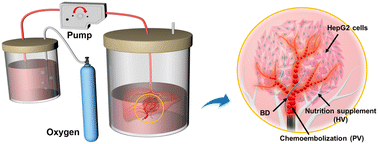Engineering orthotopic tumor spheroids with organ-specific vasculatures for local chemoembolization evaluation†
Abstract
Developing a three-dimensional (3D) in vitro tumor model with vasculature systems suitable for testing endovascular interventional therapies remains a challenge. Here we develop an orthotopic liver tumor spheroid model that captures the organ-level complexity of vasculature systems and the extracellular matrix to evaluate transcatheter arterial chemoembolization (TACE) treatment. The orthotopic tumor spheroids are derived by seeding HepG2 cell colonies with controlled size and location surrounding the portal triads in a decellularized rat liver matrix and are treated by clinically relevant drug-eluting beads embolized in a portal vein vasculature while maintaining dynamic physiological conditions with nutrient and oxygen supplies through the hepatic vein vasculature. The orthotopic tumor model exhibits strong drug retention inside the spheroids and embolization location-dependent cellular apoptosis responses in an analogous manner to in vivo conditions. Such a tumor spheroid model built in a decellularized scaffold containing organ-specific vasculatures, which closely resembles the unique tumor microenvironment, holds the promise to efficiently assess various diagnostic and therapeutic strategies for endovascular therapies.



 Please wait while we load your content...
Please wait while we load your content...